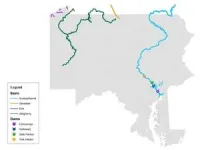(Press-News.org) UNIVERSITY PARK, Pa. — In an attempt to rescue a rare darter in the lower Susquehanna River, a Penn State research team, working with the Pennsylvania Fish and Boat Commission, has determined that the fish is a distinct subspecies found nowhere else. And that makes the effort to restore its population even more important, the researchers say.
A yellow- to olive-colored member of the darter family with dark bars often arrayed in zebra fashion, the Chesapeake logperch is typically just a few inches long, with a small mouth and a short, conical snout. It is believed to only ever have inhabited the lower drainages of the Susquehanna and Potomac rivers, and it has not been seen in the Potomac since the late 1930s.
To reach their conclusion that the Chesapeake logperch, Percina bimaculata, is one of a kind — recently published in Fishes — the researchers collected thousands of specimens of logperch using seines, electrofishing units and electrified benthic trawls from the Allegheny River, from tributaries of Lake Erie and from the lower Susquehanna River. They also included specimens from the Mississippi River drainage, collected in Illinois and Minnesota and stored at the Illinois Natural History Survey, in the study.
To compare the fish from the different populations, researchers made 18 measurements and seven counts on specimens, quantifying characteristics such as the presence or absence of scales on the fishes’ nape, and the number of rays of the pectoral fin, lateral-line scales and gill rakers.
“We concluded that the Chesapeake logperch found in the lower Susquehanna River and a few of its tributaries is not the same as closely related fish found in the other drainages,” said team leader Jay Stauffer, distinguished professor of ichthyology at Penn State. “That makes our project to rescue and reintroduce the fish into the river and tributaries even more urgent.”
Stauffer and his research group in Penn State's College of Agricultural Sciences, in conjunction with Doug Fischer of the Pennsylvania Fish & Boat Commission, just concluded a four-year effort to restore the logperch population in the lower Susquehanna, which was funded by grants totaling almost $500,000 from the Pennsylvania Fish and Boat Commission and the Pennsylvania Wild Resources Fund.
For the reintroduction, Stauffer and several graduate students completed underwater snorkel surveys in sections of the lower Susquehanna and select tributaries, capturing Chesapeake logperch and determining which habitats the fish frequents. They surveyed and collected fish from the Susquehanna River below the Holtwood Dam in Pennsylvania and in six tributaries.
In Maryland, the researchers collected darters from just below Conowingo Dam and in the Susquehanna Flats at the river's mouth in the Chesapeake Bay.
The researchers then cultured — which means breeding and raising in this context — some 2,000 Chesapeake logperch in Penn State facilities and introduced the fish into selected spots with good habitats in their historical range in the Susquehanna River drainage.
“We tagged all Chesapeake logperch that were cultured before releasing them so they could be identified later, and we were able to recapture a few around Columbia,” Stauffer said. “And we also put electronic tags in a whole series of fish we put in Conodoquinet Creek, to see if they migrate out to the Susquehanna River. Unfortunately, we didn’t have enough time to see if they came back to spawn, so we're continuing some of this work and seeking other funding.”
The fish has been a victim of past pollution, Stauffer pointed out, but now is threatened by predation by voracious invasive fishes, including the northern snakehead, flathead catfish and blue catfish that are colonizing the lower Susquehanna. The numbers of the Chesapeake logperch have dwindled significantly in the river and a few of its tributaries.
“Few people realize how serious and pervasive the threat invasive predatory fish present to native benthic fish fauna,” Stauffer said.
Already listed as endangered in Pennsylvania and Maryland, the Chesapeake logperch is on the verge of being added to the federal endangered species list. That could have dire consequences for the lower Susquehanna River, Stauffer warned.
“We don't want to see that happen, because the Chesapeake logperch being federally listed would cause a lot of problems with development in the lower Susquehanna River basin and also with development around the upper Chesapeake Bay,” he said. “We think that we can restore the Chesapeake logperch to its original distribution in the Susquehanna River by culturing and translocating it and reintroducing it to its native habitat. But it is going to take some more time and perhaps more introductions.”
The effort to save the Chesapeake logperch is novel, Stauffer said he believes.
“There has been quite a bit of work done in the last 10 years or so trying to restore fishes to their habitats, but there are not many restoration projects of this magnitude with a species that has not been federally listed,” he said. “To try to prevent a species from being federally listed is pretty unique.”
Why go to all this trouble to save this unimpressive little fish? Stauffer admitted he has asked himself that question. Because the Chesapeake logperch has no commercial value and it is not of recreational importance, a conventional cost-benefit analysis on losing the fish cannot be performed, he conceded.
“If it goes extinct, we have lost another species that inhabits the Earth,” he said. “I think there is something to be said for preserving the biodiversity of our aquatic systems. When a species goes extinct, it's gone forever. You don't get it back.”
At one point, Stauffer, 72, viewed the just-concluded first phase of the Chesapeake logperch rescue and reintroduction as his final research project. But now he wants to finish the job.
“I think I’m going to see this thing though and not retire for a while,” he said.
Contributing to the research were Jonathan Freedman, former graduate student; Douglas Fischer, Pennsylvania Fish and Boat Commission; and Robert Criswell, retired from the Pennsylvania Game Commission.
Funding for this research was provided by the Department of the Interior, the U.S. Fish and Wildlife Service, the Wild Resources Conservation Program and the U.S. Department of Agriculture’s National Institute of Food and Agriculture.
END
Penn State researchers discover one-of-a-kind fish is local to lower Susquehanna
Finding makes effort to rescue, replenish river’s population more urgent, researchers say
2023-06-26
ELSE PRESS RELEASES FROM THIS DATE:
CHEST® Critical Care launches first issue
2023-06-26
Glenview, Illinois – A new scientific publication, CHEST® Critical Care, published its inaugural issue June 22, 2023. As part of the journal CHEST® portfolio, this online-only publication is dedicated entirely to the field of critical care medicine.
“I’m ecstatic for this launch. We are grateful to our authors for the trust they put in us and are excited to share their work with our critical care colleagues around the world,” says Hayley Gershengorn, ...
Fighting loneliness by finding purpose
2023-06-26
A new study co-authored by Patrick Hill, associate professor of psychological and brain sciences, offers an important message for our times: A sense of purpose in life — whether it’s a high-minded quest to make a difference or a simple hobby with personal meaning — can offer potent protection against loneliness.
“Loneliness is known to be one of the biggest psychological predictors for health problems, cognitive decline, and early mortality,” Hill said. “Studies show that it can ...
Worse than diesel and gasoline? Bioenergy as bad as fossils if there is no pricing of CO2 emissions from land-use change
2023-06-26
Demand for modern biofuels is expected to grow substantially in order to mitigate climate emissions. However, they are far from being a climate neutral alternative to gasoline and diesel. A new study in Nature Climate Change shows that under current land-use regulations, CO2 emission factors for biofuels might even exceed those for fossil diesel combustion due to large-scale land clearing related to growing biomass. Before bioenergy can effectively contribute to achieving carbon neutrality, international agreements need to ensure the effective protection of forests and other natural lands by introducing carbon ...
New research clarifies connection between autism and the microbiome
2023-06-26
The biological roots of autism continue to perplex researchers, despite a growing body of studies looking at an increasing array of genetic, cellular and microbial data. Recently, scientists have homed in on a new and promising area of focus: the microbiome. This collection of microbes that inhabit the human gut has been shown to play a role in autism, but the mechanics of this link have remained awash in ambiguity. Taking a fresh computational approach to the problem, a study published today in Nature Neuroscience sheds new light on the relationship between the microbiome and autism. This research — which originated ...
Study shows unsafe storage of firearms continues to put guns in the hands of children
2023-06-26
(COLUMBUS, Ohio) – Firearms are the leading cause of death among children and teens 1-19 years old in the United States. According to new research from Nationwide Children’s Hospital, most unintentional firearm fatalities in which a child shoots another child involve boys, occur in the child’s home or at the home of a friend, and involve firearms that were stored loaded and unlocked.
In a new study, researchers at the Center for Injury Research and Policy at Nationwide ...
The Gerontological Society of America selects 2023 Fellows
2023-06-26
The Gerontological Society of America (GSA) — the nation’s largest interdisciplinary organization devoted to the field of aging — has named 49 exemplary professionals as its newest fellows.
Fellow status is peer recognition for outstanding contributions to the field of gerontology and represents the highest category of GSA membership. This distinction comes at varying points in a person’s career and is given for diverse activities that include research, teaching, administration, public service, practice, and notable participation in the Society. Fellows are chosen from across GSA’s membership groups.
The new fellows will be formally ...
Breakthrough boosts quantum AI
2023-06-26
LOS ALAMOS, N.M., June 26, 2023 — A groundbreaking theoretical proof shows that a technique called overparametrization enhances performance in quantum machine learning for applications that stymie classical computers.
“We believe our results will be useful in using machine learning to learn the properties of quantum data, such as classifying different phases of matter in quantum materials research, which is very difficult on classical computers,” said Diego Garcia-Martin, a postdoctoral researcher ...
National Cancer Institute grant targets cancer disparities
2023-06-26
Weill Cornell Medicine and Columbia University have been awarded a $9.8 million, five-year grant from the National Cancer Institute (NCI), part of the National Institutes of Health, to help combat cancer disparities fueled by persistent poverty.
The competitive award, will engage faculty members from Weill Cornell Medicine, Columbia University Mailman School of Public Health, Columbia University School of Nursing and SUNY Downstate Health Sciences University in a collaborative effort to develop a specialized research center and spearhead two large projects in ...
SNMMI elects Jean-Luc C. Urbain, MD, PhD, FASNC, as Vice President-Elect at 2023 Annual Meeting
2023-06-26
Chicago, Illinois (Embargoed until 9:30 am CDT, Monday, June 26, 2023)—Jean-Luc C. Urbain, MD, PhD, FASNC, professor of radiology/nuclear medicine and medicine, vice chair of theranostics, and director of nuclear medicine at Roswell Park Cancer Center at the University of Buffalo in New York, has been elected vice president-elect for the Society of Nuclear Medicine and Molecular Imaging (SNMMI). SNMMI introduced a new slate of officers during its 2023 Annual Meeting, held June 24-27.
“With the advent of new precision oncology nuclear therapies and the explosion of the field of theranostics, there has never been a more exciting ...
Umar Mahmood, MD, PhD, receives first annual SNMMI Minoshima-Pappas Transformational Leadership Award
2023-06-26
Chicago, Illinois (Embargoed until 9:30 am, CDT, Monday, June 26, 2023)—Umar Mahmood, MD, PhD, chief of Nuclear Medicine and Molecular Imaging, director of the Center for Precision Imaging, and associate chair for imaging sciences in the Department of Radiology at Massachusetts General Hospital and professor of radiology at Harvard Medical School in Boston, Massachusetts, has been named as the first recipient of the new Minoshima-Pappas Transformational Leadership Award. Mahmood was presented the award by the Society of Nuclear Medicine and Molecular Imaging (SNMMI) at its 2023 Annual Meeting.
The Minoshima-Pappas Transformational Leadership Award was ...
LAST 30 PRESS RELEASES:
Scientists ID potential way to prevent brain injuries from triggering Alzheimer's
MASTER 2nd Open Call: Execution period kick-off
Algae for health in food and pharma
Advanced microrobots driven by acoustic and magnetic fields for biomedical applications
Chicago health information leader recognized for raising CPR readiness and blood pressure awareness
The Intimate Animal, a new book from Kinsey Institute Executive Director Dr. Justin Garcia
When blue-collar workers lose union protection, they try self-employment
New video dataset to advance AI for health care
MEA-based graph deviation network for early autism syndrome signatures in human forebrain organoids
New modeling approach sheds light on rare gut disease
Study documents potentially hazardous flame retardants in firefighter gear
Can certain bacteria regulate aging of the immune system and its related alterations?
AI model helps diagnose often undetected heart disease from simple EKG
There are fewer online trolls than people think
Cell membrane fluctuations produce electricity
Jeonbuk National University study shows positive parenting can protect adolescents against self-harm
Surface-engineered ZnO nanocrystals to tackle perfluoroalkyl substance contamination
This new understanding of T cell receptors may improve cancer immunotherapies
A new fossil face sheds light on early migrations of ancient human ancestor
A new immunotherapy approach could work for many types of cancer
A new way to diagnose deadly lung infections and save lives
40 percent of MRI signals do not correspond to actual brain activity
How brain-inspired algorithms could drive down AI energy costs
Gum disease may be linked to plaque buildup in arteries, higher risk of major CVD events
Contrails are a major driver of aviation’s climate impact
Structure of dopamine-releasing neurons relates to the type of circuits they form for smell-processing
Reducing social isolation protects the brain in later life
Keeping the heart healthy increases longevity even after cancer
Young adults commonly mix cannabis with nicotine and tobacco
Comprehensive review illuminates tau protein's dual nature in brain health, disease, and emerging psychiatric connections
[Press-News.org] Penn State researchers discover one-of-a-kind fish is local to lower SusquehannaFinding makes effort to rescue, replenish river’s population more urgent, researchers say



